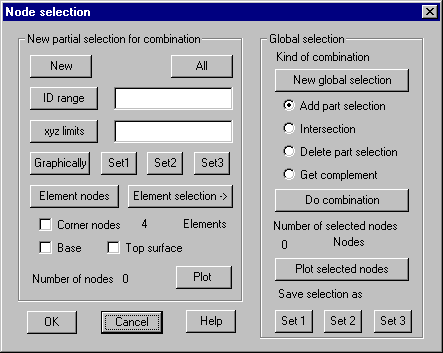Node Selection: Select nodes to be affected by a
command
The dialog box
will be popped up if inside another dialog the button “New selection” is
pressed for getting a node selection. This dialog may also be invoked
independent of another command. It offers the possibility of specifying and
saving 3 different selection sets, which can later be activated by other
commands.
The dialog
remains active until it's explicitly closed by "OK" or
"Cancel". New partial selections can be specified multiple times,
which can be combined with the current global selection by different ways (see
"Kind of combination").
By pressing the
“Plot” button the current selection can be graphically checked. Within a new
display list selected nodes are marked with a colored symbol.
Button „Do
combination“ combines the current partial selection with the global selection
using the given parameters and produces a new global selection. The number of
selected nodes is shown. Default for the global selection is always the latest
chosen selection except the latest selection contained all nodes. In this case
the global selection is set to zero.
Following
options are available:

New partial
selection for combination
For
specifying a new partial selection for a combination with the global selection
the following alternatives are available:
New:
Erase current partial selection.
All: All
nodes are selected.
ID range:
First and last ID of a range of IDs must be given.
xyz limits:
All nodes are selected which are inside a given cube. Input parameters for the
cube are xl, xr, yl, yr, zl, zr, cs that are the left and right coordinates of
the cube within a given coordinate system cs.
Set1-Set3:
Actual saved selection within this set is used.
Graphically: Following selection has to be done graphically within the OpenGL
window. All selectable nodes are marked by a symbol. A dialog box pops up where
you should choose the kind of the graphically selection.
Element nodes: All nodes of the current selected elements are selected. With option
„Corner nodes“ marked only element vertices are selected without nodes on
edges, with option „Base“ or „Top surface“ marked, only node of the base or top
surface of solid elements are selected, With button „Element selection“ the
active element selection used by this command can prior be defined.
Plot:
Pressing this button plots the partial selection.
Kind of
combination
Following
alternatives for the combination of a new partial selection with the global
selection are available:
New global selection: The current global selection will be erased.
Add pat selection: New partially selected nodes are merged with the global selection.
Intersection: The intersection between new partial selection and global selection
builds the new global selection, i.e. only those nodes contained within both
sets are selected.
Delete part selection: New partial selected nodes are removed from the current selection.
Get complement: A complement set is build, i.e. all currently not selected nodes are
contained within the new global selection.
Do combination: Pressing this button will cause the combination of the partial and
global selection to be done.
Plot selected nodes: Pressing this button, the current global selection can be checked
graphically.
Save
selection as
The
current selection will be saved within the chosen set and can be used by
following commands. Saved are the external node ID's, i.e. the set remains
valid until numbering won't be changed.